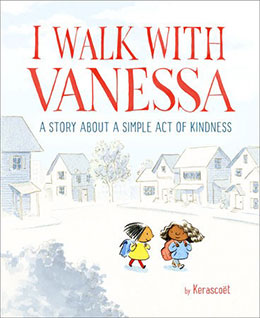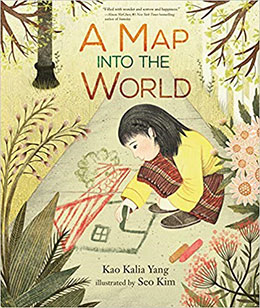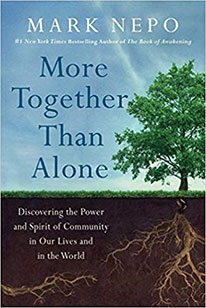Caren: “More Together than Alone,”
Peace and the Sense of Belonging
Home. Community. A sense of belonging. Don’t we all long for love and connection? And when the anchored sense of belonging disappears, we spot it — on the drawn face of a child alone on a playground or on an elderly face of someone alone on a park bench. Haven’t we all felt that moment of dislocated loneliness? If no one reaches out to us and brings us into a circle of kindness, loneliness can twist into dangerous alienation. “More together than alone” a phrase used by poet, author, and teacher, Mark Nepo, is my new mantra.
Recently two picture books have caught my eye that speak to a sense of belonging. In each of these quiet stories, a child reaches beyond her own secure circle to include a lonely person in need of a friend:
 I Walk with Vanessa: A Story About a Simple Act of Kindness by Kerascoet (Schwartz & Wade Books) is an expressive, wordless picture book that captures Vanessa’s lonely feelings as a new student and her fright when the class bully verbally attacks her on her way home from school. A girl in a yellow dress watches from a distance then finds kindness and courage to reach out to Vanessa in friendship. It’s a small gesture, but one that multiplies. Eventually an entire community of happy friends accompany Vanessa on her way to school the next morning. The mantra, “more together than alone” rescues Vanessa and strengthens the compassion of the community of kids.
I Walk with Vanessa: A Story About a Simple Act of Kindness by Kerascoet (Schwartz & Wade Books) is an expressive, wordless picture book that captures Vanessa’s lonely feelings as a new student and her fright when the class bully verbally attacks her on her way home from school. A girl in a yellow dress watches from a distance then finds kindness and courage to reach out to Vanessa in friendship. It’s a small gesture, but one that multiplies. Eventually an entire community of happy friends accompany Vanessa on her way to school the next morning. The mantra, “more together than alone” rescues Vanessa and strengthens the compassion of the community of kids.
 A Map Into the World by Kao Kalia Yang, illustrated by Seo Kim (Carolrhoda Books), is a touching story of Paj Ntaub, a sensitive young Hmong girl whose family moves into a new home in a new neighborhood in their newly adopted country. Across the street are Bob and Ruth, an older couple who sit on a bench and wave hello. Summer turns to fall. Paj Ntaub’s home fills with the liveliness of baby twin brothers and Paj Ntaub’s own growing up. Winter comes. Sadly, neighbor Ruth dies. Then spring arrives. Without Ruth, Bob sits on the bench by himself. Paj Ntaub senses Bob’s loneliness. With her bucket of chalk, Paj Ntaub draws pictures of her year on the sidewalk and an arrow pointing to her house. The chalk drawings are an invitation, “a map into the world,” a way for Bob to reconnect after loss. The mantra echoes again: “More together than alone.”
A Map Into the World by Kao Kalia Yang, illustrated by Seo Kim (Carolrhoda Books), is a touching story of Paj Ntaub, a sensitive young Hmong girl whose family moves into a new home in a new neighborhood in their newly adopted country. Across the street are Bob and Ruth, an older couple who sit on a bench and wave hello. Summer turns to fall. Paj Ntaub’s home fills with the liveliness of baby twin brothers and Paj Ntaub’s own growing up. Winter comes. Sadly, neighbor Ruth dies. Then spring arrives. Without Ruth, Bob sits on the bench by himself. Paj Ntaub senses Bob’s loneliness. With her bucket of chalk, Paj Ntaub draws pictures of her year on the sidewalk and an arrow pointing to her house. The chalk drawings are an invitation, “a map into the world,” a way for Bob to reconnect after loss. The mantra echoes again: “More together than alone.”
Caren: Going Deeper
 I shared Mark Nepo’s book titled More Together Than Alone with Ellie. Nepo’s book is a collection of stories that lift up moments across history and cultures when human beings came together in creativity, empathy, collaboration, and enlightenment.
I shared Mark Nepo’s book titled More Together Than Alone with Ellie. Nepo’s book is a collection of stories that lift up moments across history and cultures when human beings came together in creativity, empathy, collaboration, and enlightenment.
To contrast cultural moments, Nepo first introduces two fictional tribes: The “Go Away” tribe believes in strict laws, clear borders, and loyalty. The “Go Aways” meet the stranger and says, “You’re different, go away.” The other is the “Come Teach Me” tribe. This tribe is willing to cross borders, build bridges, and welcome the stranger. Wisely, Nepo reminds us that “we are born into both tribes and can move from one to the other, depending on the level of our fear.”
Nebo compares the “noise level” of fear and violence and acts of kindness. Fear and violence are loud, disruptive, disturbing, and can blind us like a sandstorm. Acts of compassion and kindness are quiet and often go unacknowledged. More Together Than Alone lifts up quiet, historical times of enlightenment for adults. I Walk with Vanessa and A Map Into the World offer the same message to children.
Listen to Mark Nepo speak about More Together Than Alone.
Ellie: Action Steps
Often children are natural boundary crossers, willing to reach out to one another. How do we lose that unencumbered audacity as adults? We can practice together as we cross boundaries to better understand ourselves, cross interpersonal boundaries to better know the person next to us, and cross systemic boundaries to better know people who are different from us. The work is not easy, nor comfortable. It takes practice, a willingness to be open, a desire to be a member of the “Come Teach Me” tribe.” Each step, no matter the effort, takes us closer to understanding that we are “more together than alone.”
- Ask yourself where are the boundaries in your school or community? What and who are you taught not to see?
- Walk around your school or community and see something new.
- Make a point to talk to a neighbor or someone new at your school.
- Put yourself in a situation where you are interacting with someone who the world has called “the other.”
- Invite a partner to come on this journey with you.
For each Peace-ology post, Caren and Ellie partner to learn and explore the meaning of peace — out loud. If you’d like to share your ideas about peace, books, children and living our lives, please share your comments here, or visit their websites.

What a healthy mindset to encourage. Thank you.